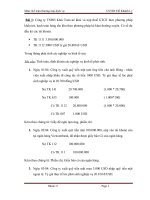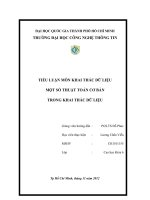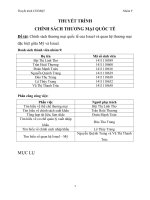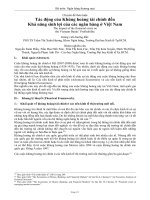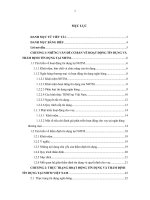tiểu luận môn khai thác thương mại tàu bay
Bạn đang xem bản rút gọn của tài liệu. Xem và tải ngay bản đầy đủ của tài liệu tại đây (2.14 MB, 31 trang )
<span class="text_page_counter">Trang 2</span><div class="page_container" data-page="2">
<b>HỌC VIỆN HÀNG KHÔNG VIỆT NAM KHOA QUẢN TRỊ KINH DOANH </b>
</div><span class="text_page_counter">Trang 3</span><div class="page_container" data-page="3">L<b>ỜI CẢM ƠN</b>
Nhóm chúng em xin chân thành cảm ơn ThS Đỗ Uyên Tâm đã đồ. ng hành, truyền đạt và giúp đỡ chúng em trong suốt q trình. Những kiến thức và kinh nghiệm mà cơ gi ng dả ạy đã giúp chúng em hoàn thành bài tập nhóm m t cách t t nh t. Mộ ố ấ ặc dù đã cố gắng hết sức, song bên cạnh đó nhóm chúng em cũng khó tránh khỏi sai sót, chúng em r t mong nhấ ận được s góp ý và ch nh s a tự ỉ ử ừ cơ để bài t p nhóm c a chúng ậ ủem có thể hồn thiện hơn.
Chúng em xin chân thành cảm ơn cô!
</div><span class="text_page_counter">Trang 4</span><div class="page_container" data-page="4">L<b>ỜI MỞ ĐẦ</b>U
Môn Khai thác thương mại tàu bay là một môn vô cùng cần thiết đối với sinh viên ngành Qu n tr kinh doanh nói riêng và sinh viên H c vi n Hàng khơng nói ả ị ọ ệchung. Thông qua môn h c và bài t p nhóm l n này chúng em có th hi u sâu sọ ậ ầ ể ể ắc hơn về các đặc trưng, tính chất và cách tính tốn các thông s m t cách h p lý nhố ộ ợ ất. Điều này r t có ích trong vi c trau dấ ệ ồi và đúc kết ki n th c mế ứ ới, đồng thời cũng là hành trang đáng quý cho chúng em trước ngưỡng cửa tiếp xúc trực tếp với các hoạt động trong ngành hàng không sắp tớ i.
</div><span class="text_page_counter">Trang 5</span><div class="page_container" data-page="5"><b>MỤC LỤC </b>
<b>PHẦN I: B NG K T QU ... 1 ẢẾẢ</b>
4-1 Apron Plan Spot, GSE yard ... 1 . ( )
4-1-1. Calculation of required number of spots (loading apron) ... 1
4-1-2. Calculation of the area of the GSE yard (passenger terminal area) ... 1
4-1-3. Calculation of the area of the GSE yard (cargo terminal area) ... 1
4-2. Passenger Terminal Area Plan (Passenger Terminal Building, Parking Lot ... 2 )
4-2-1. Calculation of the size of the domestic passenger terminal building and required land area ... 2
4-2-2. Calculation of size of parking lot and required land area ... 2
4-3 Cargo Terminal Area Plan ... 3 .
4-3-1. Calculation of the floor area of the cargo terminal building and required land area ... 3
4-4 Fueling Facility Area Plan ... 4 .
4-4-1. Calculation of size of fueling facilities and required land area ... 4
<b>PHẦN II : DIỄN GIẢI CHI TIẾ</b>T ... 5
4. Calculation of the necessary size of facilities and required land are ... 5
4-1 Apron Plan Spot, GSE yard ... 5 . ( )
4-1-1. Calculation of required number of spots (loading apron) ... 5
4-1-2. Calculation of the area of the GSE yard (passenger terminal area) ... 8
4-1-3. Calculation of the area of the GSE yard (cargo terminal area) ... 11
4-2. Passenger Terminal Area Plan (Passenger Terminal Building, Parking Lot . 12 )4-2-1. Calculation of the size of domestic passenger terminal building and required land area. ... 12
4-2-2. Calculation of size of parking lot and required land areaư ... 14
4-3 Cargo Terminal Area Plan ... 15 .
4-3-1. Calculation of the floor area of the cargo terminal building and required land area ... 15
4-4 Fueling Facility Area Plan ... 18 .
4-4-1. Calculation of size of fueling facilities and required land area ... 18
</div><span class="text_page_counter">Trang 6</span><div class="page_container" data-page="6"><b>PHẦN I: B NG K T QU ẢẾẢ</b>
4. Calculation of the necessary size of facilities and required land are 4-1 Apron Plan Spot, GSE yard . ( )
4-1-1. Calculation of required number of spots (loading apron)
4-1-2. Calculation of the area of the GSE yard (passenger terminal area)
4-1-3. Calculation of the area of the GSE yard (cargo terminal area)
</div><span class="text_page_counter">Trang 7</span><div class="page_container" data-page="7">2 4-2. Passenger Terminal Area Plan (Passenger Terminal Building, Parking Lot )4-2-1. Calculation of the size of the domestic passenger terminal building and required land area
4-2-2. Calculation of size of parking lot and required land area
</div><span class="text_page_counter">Trang 8</span><div class="page_container" data-page="8">4-3 Cargo Terminal Area Plan .
4-3-1. Calculation of the floor area of the cargo terminal building and required land area
</div><span class="text_page_counter">Trang 9</span><div class="page_container" data-page="9">4 4-4 Fueling Facility Area Plan .
4-4-1. Calculation of size of fueling facilities and required land area
</div><span class="text_page_counter">Trang 10</span><div class="page_container" data-page="10"><b>PHẦN II : DIỄN GIẢI CHI TIẾT </b>
Diễn giải s u bố liệ ảng năm 2017
4. Calculation of the necessary size of facilities and required land are 4-1 Apron Plan Spot, GSE yard . ( )
4-1-1. Calculation of required number of spots (loading apron) C: Peak day aircraft take-offs/landings
Căn cứ vào b ng (2) Annual number of passengers by route, Aircraft take-offs / ảlandings by type, Annual cargo handling volume ở m c 3. Prediction of civil ụaviation demand. T ừ đó ta có:
• C(JJ) = 2 • C(LJ) = 6 • C(MJ) = 28 • C(SJ) = 34 • C(PR) = 0
Suy ra Total = C(JJ) + C(LJ) + C(MJ) + C(SJ) + C(PR) = 7 d: Concentration ratio of flights in peak hour
Ta th y các chuyấ ến bay đều là các chuy n bay qu c nế ố ội nên d được tính b ng ằcơng th c ứ sau:
<b>Peak – period concentration rate : d </b>
and landing number of times
d = 6.61 ÷ take – off and landinnumber of times + 0.064
number of times + 0.114
</div><span class="text_page_counter">Trang 11</span><div class="page_container" data-page="11">6 Ta th y các chuyấ ến bay đều là các chuy n bay qu c n i và sế ố ộ ố lượng chuy n ếbay là 70 nh ỏ hơn 100 nên d được tính b ng cơng thằ ức sau:
d = 1.51 : Number of take-off landing times + 0.115 T <b>ừ đó, ta tính ra đượ</b>c d = 0.1366.
F:Aircraft landings per peak hour by type
Ta có cơng thức sau: F = C x d x 1/2 Từ đó ta tính được:
• F(JJ) = 0.137 • F(LJ) = 0.41 • F(MJ) = 1.912 • F(SJ) = 2.322 • F(PR) = 0 g: Spot occupation time
Căn cứ vào ph n a) Calculation of the number of required spots (loading ầapron) mục 3. Apron plan, ta th y : ấ
g: Large jet aircraft: 75 minutes for domestic flights and 115 minutes for international flights
Medium jet aircraft: 75 minutes for domestic flights and 105 minutes for international flights
Small jet aircraft: 60 minutes for domestic flights and 105 minutes for international flights, etc
Từ đó ta có:• g(JJ-LJ) = 75 • g(MJ) = 75 • g(SJ) = 60
</div><span class="text_page_counter">Trang 12</span><div class="page_container" data-page="12">• g(PR) = 0 h: Allowance ratio
Căn cứ vào ph n a) Calculation of the number of required spots (loading ầapron) mục 3. Apron plan, ta th y: ấ
Rate of margin for spot possession time (=1.2)
<b>Do đó h = 1.2 </b>
The number of spots calculated
Ta thấy The number of spots calculated được tính bằng cơng thức: I = F x g/60 x h
Từ đó ta tính được:
• The number of spots calculated(JJ) = 0.205 • The number of spots calculated(LJ) = 0.615 • The number of spots calculated(MJ) = 2.868 • The number of spots calculated(SJ) = 2.786 • The number of spots calculated(PR) = 0 I: Planned number of loading spots by type
Ta phân lo i theo Large Jet Aircraft, Medium Jet Aircraft, Small Jet Aircraft, ạPropeller aircraft.
Do đó:
• I(JJ-LJ) = The number of spots calculated(JJ) + The number of spots calculated(LJ) = 0.8194
• I(MJ) = 2.868 • I(SJ) = 2.786 • I(PR) = 0
T <b>ừ đó ta tính đượ</b>c Total = 6.473
</div><span class="text_page_counter">Trang 13</span><div class="page_container" data-page="13">8 J: Required number of stand-by spots
Ta có J được tính bằng công thức sau: J = I x 0.1Từ đó ta tính được:
• J(JJ-LJ) = 0.0819 • J(MJ) = 0.2868 • J(SJ) = 0.2786 • J(PR) = 0
T <b>ừ đó ta tính đượ</b>c Total = 0.6473. U: Required number of apron spots Ta có U được tính bằng công thức sau: U = I + J Từ đó ta tính được:
• U(JJ-LJ) = 0.9014 • U(MJ) = 3.155 • U(SJ) = 3.065 • U(PR) = 0
</div><span class="text_page_counter">Trang 14</span><div class="page_container" data-page="14">b: Required GSE yard area per aircraft landing
Căn cứ vào phần f) Calculation of acreage of GSE storage area (passenger terminal area) mục 3. Apron plan, ta th y: ấ
b: Large jet aircraft B747 : 1,600 ( 1,850) m<small>2 </small>
Large jet aircraft B777 : 1,250 ( 1,350) m<small>2 </small>
Medium jet aircaft : 1,250 ( 1,350) m<small>2 </small>
Small jet aircaft : 450 ( 650) m<small>2 </small>
Propeller aircaft : 200 ( 300) m<small>2 </small>
*“()”= base airport Từ đó ta có:
• b(JJ) = 1600 • b(LJ) = 1250 • b(MJ) = 1250 • b(SJ) = 450 • b(PR) = 200 c: area per aircraft landing
Căn cứ vào ph n f) Calculation of acreage of GSE storage area (passenger ầterminal area) mục 3. Apron plan, ta th y: ấ
<b>Increase rate of airline companies regarding storage area acreage per take – off </b>
and landing time ( = 1.2)
<b>Do vậy, c = 1.2. </b>
D: Required area for the GSE yard
</div><span class="text_page_counter">Trang 15</span><div class="page_container" data-page="15">10 Ta có D được tính bằng cơng thức: D=(Axbxc)
T <b>ừ đó ta tính ra đượ</b>c D = 4999.92 Number of spots by type
Ta có Number of spots by type chính là I (Planned number of loading spots by type) ở b ng 4-1-1. Tả ừ đó ta có:
• Number of spots by type(JJ-LJ) = 0.8194 • Number of spots by type(MJ) = 2.868 • Number of spots by type(SJ) = 2.786 • Number of spots by type(PR) = 0
e: Area available for GSE yard in shoulder per spot
Căn cứ vào phần f) Calculation of acreage of GSE storage area (passenger terminal area) mục 3. Apron plan.
e: Large jet aircraft B747 : 200 m<small>2 </small>
Large jet aircraft B777 : 200 m<small>2 </small>
Medium jet aircaft : 200 m<small>2 </small>
Small jet aircaft : 160 m<small>2 </small>
Propeller aircaft: 100 m<small>2 </small>
Ta thấy:
• e(JJ-LJ) = 200 • e(MJ) = 200 • e(SJ) = 160 • e(PR) = 100
F: Usable GSE yard area in the apron shoulder
</div><span class="text_page_counter">Trang 16</span><div class="page_container" data-page="16">Ta có F được tính bằng cơng thức: F= (spot by airplane.e ) V y nên F = 1183.24 <b>ậ</b>
G: Area of GSE yard in the passenger terminal area Ta thấy G được tính bằng cơng thứ : G= D-F c <b>Do đó, G = 4999.92 </b>- 1183.24 = 3816.68
4-1-3. Calculation of the area of the GSE yard (cargo terminal area) A:Number of peak hour aircraft landings by type
Căn cứ vào số liệu từ b ng 4-1-2. Calculation of the area of the GSE yard ả(passenger terminal area). T ừ đó ta có:
• A(JJ) = 0.137 • A(LJ) = 0.41 • A(MJ) = 1.912 • A(SJ )= 2.322 • A(PR) =0
h: Required GSE yard area per aircraft landing Dựa vào thông số k ỹ thuật h
h: Large jet aircraft B747: 1,600 m<small>2 </small>
Large jet aircraft B777: 1,600 m<small>2 </small>
Medium jet aircaft: 950 m<small>2 </small>
Small jet aircaft: 70 m<small>2 </small>
</div><span class="text_page_counter">Trang 17</span><div class="page_container" data-page="17">12 • h(SJ) = 70 m <small>2</small>
c: Airline increase rate Có c = 1.2
I: Required GSE yard area in the cargo terminal area
<b>Ta có cơng thức sau: I = Σ (A x h x c) </b>
Tương đương: I = (0.137x 1600 x 1.2) + (0.41 x 1600 x 1.2) + (1.912 x 950 x 1.2) + (2.322 x 70 x 1.2) = 3424.968
4-2. Passenger Terminal Area Plan (Passenger Terminal Building, Parking Lot )4-2-1. Calculation of the size of domestic passenger terminal building and required land area.
A::Annual number of passenger (person )
Căn cứ vào bảng (2) Annual number of passengers by route, Aircraft take-offs / landings by type, Annual cargo handling volume ở m c 3. Prediction of civil ụaviation demand. T ừ đó ta có:
A = 3493948 (person) b: Peak day concentration ratio
Dựa vào lý thuyết đã cho, ta có b: Average days during the 1st and 2nd peak months: Number of passengers/number of annual passengers. 1/300 tends to be used often in Japan
</div><span class="text_page_counter">Trang 18</span><div class="page_container" data-page="18">Dựa vào b ng (2) Annual number of passengers by route, Aircraft take-offs / ảlandings by type, Annual cargo handling volume ở m c 3. Prediction of civil ụaviation demand. Ta có T ng Take-ổ off and landing number of times trong năm 2017 = 70. Mà d = 1.51 / Take-off and landing number of times + 0.1115 ( in case of 100 flights/day or less)
⇒ d = 1.51/70 + 0.115 = 0.1366
E: Number of peak hour passengers (person) Ta có cơng thức: E = C x d ⇒
⇒ E = 11646.49 x 0.1366 = 1590.58 ( person)
f : Floor area of passengers terminal building/peak hour passenger (m )/ <small>2</small>
person)
Ta có cơng thức: f = 21.6 - 0,9 x ln (E) ⇒
h : Terminal building level factor
Dựa vào dữ liệu mục 4c) Passenger terminal layer method
</div><span class="text_page_counter">Trang 19</span><div class="page_container" data-page="19">14 ⇒ Sân bay Kitakyushu là sân bay 1.5 cao t ng ầ
Mà G = 23803.53 ( > 5000m vuông ) k t h p vế ợ ới sân bay ở ạ d ng 1,5 cao trình ⇒
⇒ h = 1.5
I: Building area of terminal building (m<small>2</small>) Ta có I = G/h (m ) <small>2</small>
=> I = 23803.53/1.5 = 15869.02 (m<small>2</small>)m: Land area ratio for terminal building m: "2.0" is used in Japan. ⇒
⇒ m = 2
N: Land area of terminal building (m<small>2</small>) Ta có N = I x m (m ) <small>2</small>
=> N = 15869.02 x 2 = 31738.04 (m ) <small>2</small>
4-2-<b>2. Calculation of size of parking lot and required land areaư</b>
A::Annual number of passengers (person )
Dựa vào s ố liệu A ở ả b ng 4-2-1, ta có A = 3493948 (person) b: Peak day concentration ratio
Dựa vào s ố liệu b b ng 4-2-1ở ả , ta có b = 1/300 C: Number of peak day passengers (person)
Dựa vào s ố liệu C ở ả b ng 4-2-1, ta có C = 11646.49 (person) d: Peak hour concentration ratio
Dựa vào s ố liệu d b ng 4-2-1ở ả , ta có d = 0.1366 E: Number of peak hour passengers (person)
</div><span class="text_page_counter">Trang 20</span><div class="page_container" data-page="20">Dựa vào s ố liệu E ở ả b ng 4-2-1, ta có E = 1590.58 (person) f: Parking capacity (cars) per peak hour passengers (car) Theo đề cho f = 1.0
G: Required floor area of passenger terminal building (m<small>2</small>) Ta có G = E x f (m ) <small>2</small>
⇒ I = 1590.58 x 35 = 55670.24 (m ) <small>2</small>
Taxi pool (m<small>2</small>)
Đề cho taxi pool = 2000 (m ) <small>2</small>
Bus pool (m<small>2</small>)
Đề cho bus pool = 2000 (m ) <small>2</small>
4-3 Cargo Terminal Area Plan .
4-3-1. Calculation of the floor area of the cargo terminal building and required land area
A: Annual cargo handling volume (ton )
Căn cứ vào b ng (2) Annual number of passengers by route, Aircraft take-offs / ảlandings by type, Annual cargo handling volume ở m c 3. Prediction of civil ụaviation demand. T ừ đó ta có:
A = 23230 (ton)
b: Cargo handling volume per unit tons/ m ) ( <small>2</small>
</div><span class="text_page_counter">Trang 21</span><div class="page_container" data-page="21">16 Ta có cơng thức C (tons/ m ) = 2.20ln(X) - 8.78 <small>2</small>
Theo hình h1 sẽ là kho ng cách t airline shed - ả ừ agent’s building.
</div><span class="text_page_counter">Trang 22</span><div class="page_container" data-page="22"><b>Dựa vào b ng sau suy ra: h1 = 40m ả</b>
Landside depth: h
Segregation
Airline shed to agency building 40 m
Depth of land area for cargo terminal (m)
Depth of land area for cargo terminal = (f1 + f2 + h1 + h2 + i) Depth of land area for cargo terminal = 20 + 10 + 40 + 10 + 10 = 90 (m) L: Land area for cargo terminal (m<small>2</small>)
</div><span class="text_page_counter">Trang 23</span><div class="page_container" data-page="23">18 Có L = G x (f1+f2+h1+h2+i)
L= 97.331 x 90 = 8759.774 (m ) <small>2</small>
4-4 Fueling Facility Area Plan .
4-4-1. Calculation of size of fueling facilities and required land area Route Shin-Chitose
A : Peak day aircraft take-offs by type and route
Căn cứ vào b ng (2) Annual number of passengers by route, Aircraft take-offs / ảlandings by type, Annual cargo handling volume ở m c 3. ụ Prediction of civil aviation demand. T ừ đó ta có:
• A(JJ) = 0 • A(LJ) = 0 • A(MJ) = 4 • A(SJ) = 4
b : Fuel consumption (kl) Căn cứ vào các công thức sau:
Fuel consumption : b Airplane
X: Route distance (km) Y: Fuel consumption Large jet aircraft (B747) Y= 0.0130 X + 4.80 Large jet aircraft (Airbus) Y= 0.0098 X + 3.70
</div><span class="text_page_counter">Trang 24</span><div class="page_container" data-page="24">ng v ng lo i tàu bay, ta có
• b(JJ) = 0.0130 x 1530 + 4.8 = 24.69 (kl) • b(LJ) = 0.0098 x 1530 + 3.70 = 18.694 (kl) • b(MJ) = 0.0076 x 1530 + 3.20 = 14.828 (kl) • b(SJ) = 0.0041 x 1530 + 0.75 = 7.023 (kl) C : Peak day fuel supply (kl)
Ta có C = A x b Từ đó tính được
• C(JJ) = A(JJ) x b(JJ) = 0 x 24.69 = 0 (kl) • C(LJ) = A(LJ) x b(LJ) = 0 x 18.694 = 0 (kl) • C(MJ) = A(MJ) x b(MJ) = 4 x 14.828 = 59.312 (kl) • C(SJ) = A(SJ) x b(SJ) = 4 x 7.023 = 28.092 (kl)
=> Total = C(JJ) + C(LJ) + C(MJ) + C(SJ) = 0 + 0 + 59.312 + 28.092 = 87.404 (kl) Route Tokyo
A : Peak day aircraft take-offs by type and route
Căn cứ vào b ng (2) Annual number of passengers by route, Aircraft take-offs / ảlandings by type, Annual cargo handling volume ở m c 3. Prediction of civil ụaviation demand. T ừ đó ta có:
• A(JJ) = 2 • A(LJ) = 4 • A(MJ) = 12 • A(SJ) = 0
b : Fuel consumption (kl)
Căn cứ vào các công thức cho sẵn, đối chiếu tương ứng với từng loại tàu bay, ta có:
</div><span class="text_page_counter">Trang 25</span><div class="page_container" data-page="25">20 • b(JJ) = 0.0130 x 911 + 4.8 = 16.643 (kl)
• b(LJ) = 0.0098 x 911 + 3.70 = 12.6278 (kl) • b(MJ) = 0.0076 x 911 + 3.20 = 10.1236 (kl) • b(SJ) = 0.0041 x 911 + 0.75 = 4.4851 (kl) C : Peak day fuel supply (kl)
Ta có C = A x b. Từ đó tính được
• C(JJ) = A(JJ) x b(JJ) = 2 x 16.643 = 33.286 (kl) • C(LJ) = A(LJ) x b(LJ) = 4 x 12.6278 = 50.5112 (kl) • C(MJ) = A(MJ) x b(MJ) = 12 x 10.1236 = 121.483 (kl) • C(SJ) = A(SJ) x b(SJ) = 0 x 4.4851 = 0 (kl)
=> Total = C(JJ) + C(LJ) + C(MJ) + C(SJ) = 33.286 + 50.5112 + 121.483 + 0 = 205.28 (kl)
Route Chubu
A : Peak day aircraft take-offs by type and route
Căn cứ vào b ng (2) Annual number of passengers by route, Aircraft take-offs / ảlandings by type, Annual cargo handling volume ở m c 3. Prediction of civil ụaviation demand. T ừ đó ta có:
• A(JJ) = 0 • A(LJ) = 0 • A(MJ) = 4 • A(SJ) = 4
b : Fuel consumption (kl)
Căn cứ vào các công thức cho sẵn, đối chiếu tương ứng với từng loại tàu bay, ta có: • b(JJ) = 0.0130 x 663 + 4.8 = 13.419 (kl)
• b(LJ) = 0.0098 x 663 + 3.70 = 10.1974 (kl) • b(MJ) = 0.0076 x 663 + 3.20 = 8.2388 (kl)
</div>
